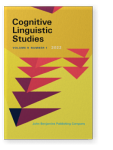Vol. 9:1 (2022) ► pp.64–86
Semantics of the Chinese passive construction with retained object
The Chinese Passive Construction with Retained Object (CPCRO) has aroused extensive attention from scholars especially advocators of Generative Grammar due to its syntactic idiosyncrasy. Previous researches primarily concerned with such syntactic idiosyncrasy concentrate on issues of its syntactic derivation but fail to provide an empirically responsible and consensual explanation for all its instantiations. This paper initiates a new perspective by focusing on its semantics on the basis of Construction Grammar. It is argued that CPCRO is a construction with its constructional meaning characterized by a causative meaning that profiles the causee’s change. This passive causative meaning is elaborated by three verb-class-specific semantic variants, i.e., the passive cause-motion variant associated with motion verbs or verbs entailing motion and specifying the causee’s change of location, the passive cause-result variant associated with verbs of making or creating and specifying the causee’s change of state, and the passive cause-receive/lose variant associated with ditransitive verbs or verbs with the potential of taking double objects and specifying the causee’s change of possession. They are structured into a polysemy network in the sense that the passive cause-result variant is metaphorically extended from the passive cause-motion variant, whereas the passive cause-receive/lose variant encoding the object-dual-based conceptualization of Event Structure directly relates to the passive cause-motion variant which encodes the location-dual-based conceptualization, and indirectly to the passive cause-result variant which preserves the location-dual-based conceptualization due to the invariance principle of metaphorical mapping, through profile shift.
Article outline
- 1.Introduction
- 2.The scope of CPCRO
- 3.Constructional meaning of CPCRO
- 4.Polysemy of CPCRO
- 5.Relations between semantic variants of CPCRO
- 6.Conclusion
- Note
-
References
